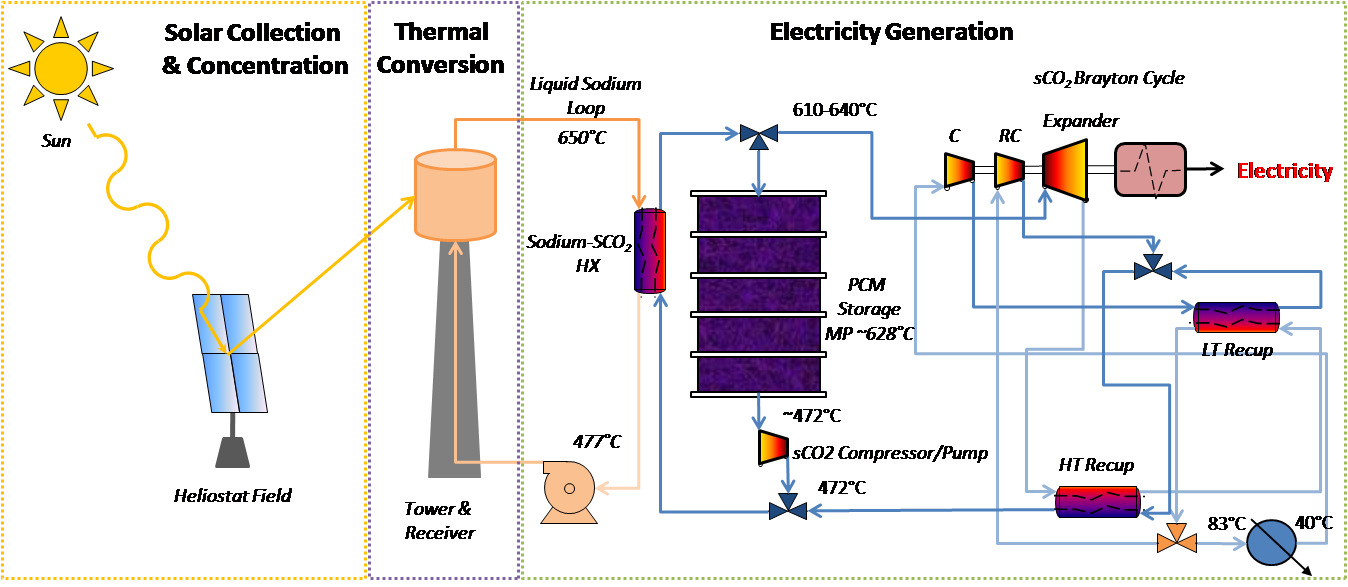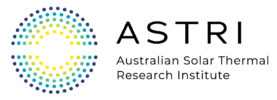ASTRI Highlights and Achievements
ASTRI has developed a concentrating solar thermal (CST) power plant configuration that could achieve a conservative levelised cost of energy (LCOE) of 12.9c/kWh, with an overall annual efficiency of 16.5%. The proposed central receiver tower power plant design is based on a 100-MWe closed-loop supercritical carbon dioxide (sCO2) Brayton cycle power block, with single-tank phase change material (PCM) thermal storage and sodium (Na) receiver. This novel configuration reflects research outcomes to date and will be further improved.

Our research into broadening the value to CST technologies has established cost targets for solar fuel plants. The ASTRI levelised cost of fuel (LCOF) targets ranges are:
- A target of $0.90/L for lignite coal feedstock and $1.0/L for solar reforming of natural gas,
- A target of $1.20/L for conventional renewable feedstock with a life-cycle emission of CO2 that is at least 10% lower than conventional diesel, and
- A target of $2.50/L for future renewable feedstock with a life-cycle emission of CO2 that is at least 50% lower than conventional diesel.
The qualitative solar fuels evaluation matrix devised in a scoping study has been revised to a quantitative matrix for comparing solar fuels from all available CST technologies and feedstocks. A published performance assessment of Fischer-Tropsch (FT) liquid fuels production using solar hybridised dual fluidised bed gasification of lignite showed the annual solar share depends of the char conversion and quality of the solar resource. For a solar multiple of 3 and bed material storage capacity of 16 h, assuming a char conversion of 100%, the annually averaged utilisation factor of the heliostat field was 40.8% and annual solar share was 21.8%.
People
ASTRI has continued to attract a diverse array of quality researchers. Over the past year, there has been particular growth in the number of students and postdoctoral fellows. Over 140 researchers have worked on ASTRI projects. Currently it has 125 people with 41 post-graduate students, 18 postdoctoral fellows, 49 researchers and 17 people in leadership roles. The ASTRI leadership roles include Principal Investigators providing strategic advice to the Director and responsible for the overall contribution of their organisation, Node Leaders responsible for delivering on key CST technology challenges based on a systems approach, and Project Leaders to deliver quality science with strategic technology outcomes.
ASTRI researchers have been participating in collaboration, project management and supervision of younger researchers. This has resulted in a strong sense of a team and purpose, with high attendance at internal events. Young researchers, such as postdoctoral fellows, have been able to take on project management roles and gain valuable leadership skills and experience.
Large-scale Collaboration
The third year of ASTRI has been devoted to using a systems approach to develop configurations that can achieve the technical goals. In addition to refining the portfolio of research project proposals to ensure system interconnectivity to meet our objectives, a gap analysis was undertaken to highlight the research topics still to be addressed. Key areas from the gap analysis were related to de-risking the configurations under consideration, which included materials science.
ASTRI continues its commitment to collaboration across the six universities and CSIRO, spanning three states and the Australian Capital Territory. This collaboration has been made possible by the wide use of teleconferencing and videoconferencing tools, as well as visits between institutions where it is deemed more appropriate. Our well-run and targeted research projects facilitate this interaction, with planned monthly meetings between multiple institutions. Project Leaders ensure that other ASTRI researchers are kept updated through monthly updates on the ASTRI wiki and monthly meetings. These have proved fruitful, with many ideas being developed.
ASTRI continues to develop its international connections with collaboration, contributions and cooperation with the US under SunShot remaining the core. A key interaction will be technical and economic review of the ASTRI configurations.
Engagement and Linkages
A core engagement for ASTRI resulted from its establishment as a Strategic Research Initiative (SRI) under the United States-Australia Solar Energy Collaboration (USASEC) in 2012. From this, Dr Ranga Pitchumani continued being the US DOE member of the ASTRI Advisory Committee until he returned to his university post. Dr Joe Stekli will take up this important role and continue encouraging collaboration and engagement with the National Renewable Energy Laboratory (NREL), Sandia National Laboratory (SNL) as well as Arizona State University (ASU).
The Director of ASTRI, Dr Manuel Blanco, has spent significant effort to network with other leaders in CST and to search for potential partnerships. In 2015 Dr Blanco was awarded a Chair of Excellence in Thermal and Fluids Engineering at Universidad Carlos III de Madrid (Spain). As part of this award he is developing and delivering a “Solar Engineering” course. His secondment in Spain allowed Dr Blanco to make contact with a range of companies in Spain and Europe. ASTRI has also looked to Europe for collaboration, with potential linkages through SolarPACES and STAGE-STE. Discussions have been held about further interactions with China, India and South Africa, who are all emerging players in CST.
Direct engagement with industry and government has resulted in a range of contributions to ASTRI projects. ASTRI has valuable in-kind support from RATCH-Australia for the mirror cleaning part of the operation and maintenance (O&M) project. Funds from the Queensland Government have helped in the development of research infrastructure for the hybrid cooling tower to be used in the supercritical carbon dioxide (sCO2) project. The total value of support from these funding partners has been $527,000. Currently, ASTRI is seeking more direct and technical involvement with particular projects, as well as more general support. Costing review is also a valuable contribution that industry can make to the ASTRI research program.
Knowledge Sharing
ASTRI’s knowledge sharing has continued to gain momentum, with an increase in publications and conference presentations, presenting research outcomes in a range of science and industry forums.
The ASTRI Annual Workshop in February 2015 was a major success with a Public Symposium on Cost Reduction Status of Concentrating Solar Thermal (CST) Technologies, bringing together researchers, industry, government, as well as international experts. The ASTRI Economic Workshop initiated a dialogue between the researchers, CST industry, and government; ultimately providing endorsement for ASTRI’s economic modelling that underpins the demonstration of technical progress. The internal workshop highlighted the direction and achievements of 2014, which were endorsed by the international experts and resulted in a media release from ARENA.
ASTRI has significantly increased the focus on communications with the appointment of a dedicated Communications Advisor. A broad range of ASTRI stakeholders including Federal Government, industry, media and partners have been engaged and briefed on program progress and milestones. This was achieved via a range of channels including events, media relations, briefings, and speaking engagements.
Key highlights were the ARENA ‘Tomorrow’s Energy Solutions Showcase’ at Parliament House which provided the opportunity to brief and engage more than 160 Parliamentarians, Senators and advisors on CST and the opportunity for Australia, as well as the opportunity created by ASTRI for Louise Vickery from ARENA to present at the annual SolarPACES conference in Cape Town, South Africa.
Two media announcements communicated the value of global collaboration in advancing CST technology developments in Australia as well as the value proposition of CST power plants with storage for Australia’s renewable energy future. The two announcements were:
- ‘Print your own 3D solar field’ – covering publication and dissemination of ASTRI’s 3D printable 25MW solar field and CST power plant model (desktop); and
- ‘ASTRI Director appointed chair of international solar thermal collaboration’ – covering Dr Manuel Blanco’s re-election as Chairman of the International Energy Agency Executive Committee for SolarPACES.
- Close collaboration with ARENA saw cross promotion of these announcements via traditional and social media platforms.
